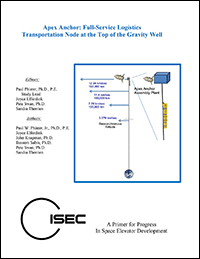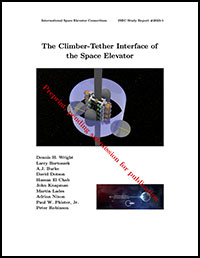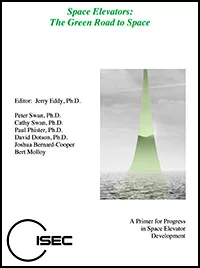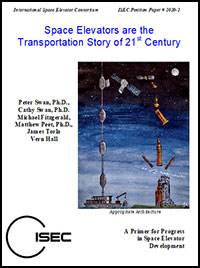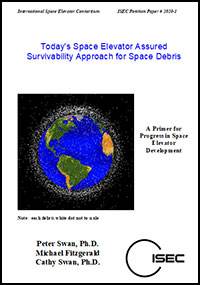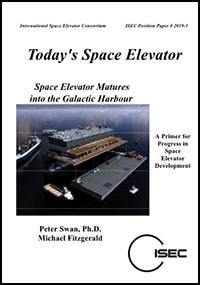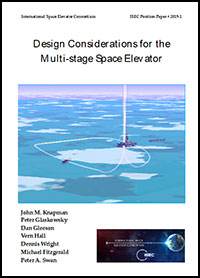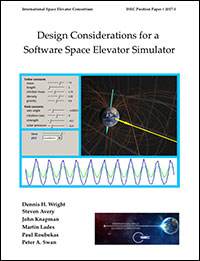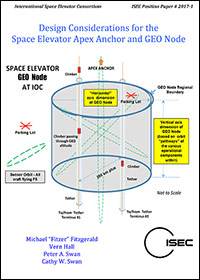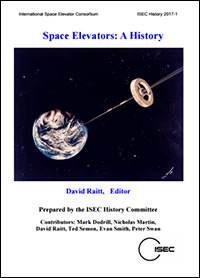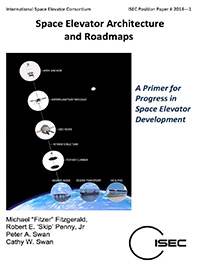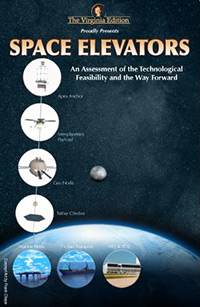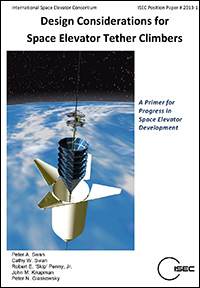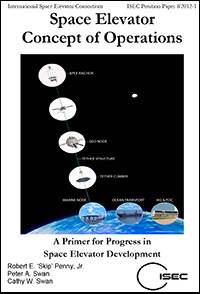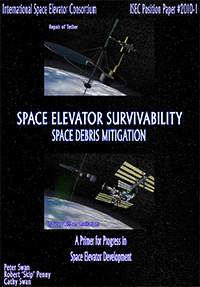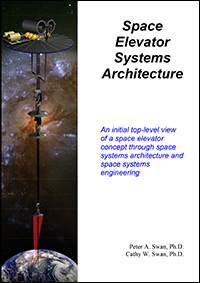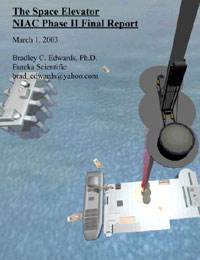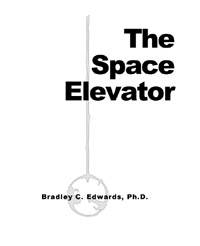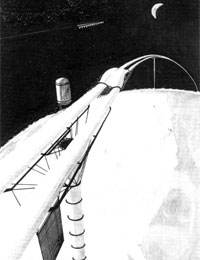Apex Anchor: Full-Service Logistics Transportation Node at Top of Gravity Well, 2024 [PDF 100 pages]. The Apex Anchor will become a Full-Service Transportation Node focused around the “Logistics Center at the top of the Gravity Well.” The inherent rapid release velocity (7.76 km/sec) at an Apex Anchor – and the ability to release every day of the year towards any destination, such as the Moon, Mars and even Pluto – opens up the universe to humanity. Printed paperback version available for purchase from Lulu.com.
Leverage Dual Space Access Architecture: Advanced Rockets and Space Elevators, 2023 [PDF 149 pages]. This Dual Space Access Strategy will ensure the future we dream of becomes a reality. Space Elevators are needed to do the “heavy lifting” for movement off planet. Their transformational characteristics will enable so many of humanity’s dreams by moving huge mass to far away destinations. May also be purchased.
The Climber-Tether Interface of the Space Elevator, 2023 [PDF 147 pages]. The conditions at the interface between the space elevator tether and climber determine whether or not climbing is possible. The construction of a tether material and a device to climb it seem possible in the near future. This study was also reported in Acta Astronautica.
Space Elevators: The Green Road to Space, 2021 [PDF 139 pages]. The International Space Elevator Consortium conducted an 18-month study by six experts looking at a Dual Space Access Architecture using both rockets and space elevators. Space Elevators are the Green Road to Space—they enable humanity’s most important missions by moving massive tonnage to GEO and beyond. They accomplish this safely, routinely, inexpensively, daily and they are environmentally neutral.
Space Elevators are the Transportation Story of the 21st Century, 2020 [PDF 147 pages]. The International Space Elevator Consortium conducted a year-long study looking at the Interplanetary strengths of an access to space architecture including space elevator permanent infrastructures and rockets. With strong materials on the horizon and new mission support capabilities being identified for it, the space elevator will be a major transportation infrastructure. May also be purchased on lulu.com after August 15, 2020.
Today’s Space Elevator Assured Survivability Approach for Space Debris., 2020 [PDF 47 pages]. The International Space Elevator Consortium conducted a year-long study looking at the recent increase in space debris environment for both the 2019 and estimated 2030 numbers. This was an update of the 2010 study and shows (again) that despite more space debris the survivability of the space elevator is assured with achievable mitigations techniques, both technical and operational. May also be purchased.
Today’s Space Elevator, a Status as of 2019, 2019 [PDF 107 pages]. The International Space Elevator Consortium conducted a year-long study looking at the recent status of the engineering development program. The space elevator concept has developed significantly over the last ten years, becoming part of a proposed global and interplanetary transportation infrastructure. The development program is ready to start significant testing of major segments. May also be purchased.
Design Considerations for the Multi-stage Space Elevator, 2018 [PDF 102 pages]. The International Space Elevator Consortium conducted a year-long study looking at the concept of multiple stages in the lower regions, enabling a less demanding tether strength. This would enable an earlier development of space elevators as well as help solve some of the atmospheric concerns. A space tower will allow the main space elevator tether to begin outside the atmosphere and to be constructed with currently available materials. May also be purchased.
Design Considerations for a Software Space Elevator Simulator, 2017 [PDF 58 pages]. A software simulator is an essential first step to the development, construction and operation of a space elevator. The simulator should be designed to meet the use cases that arise within these contexts, be developed using modern programming techniques, and use, where possible, already-existing software. A wide range of users will access the simulator, from professional developers to users in science and engineering to casual gamers. May also be purchased.
Design Considerations of a Space Elevator Apex Anchor and GEO Node, 2017 [PDF 79 pages]. The Space Elevator Transportation System is comprised of one Earth Port with two tether termini, multiple Apex Anchors supporting 100,000 km Tethers, 14 Tether Climbers, and a single Headquarters and Primary Operations Center. The GEO Node supports the Space Elevator Transportation System with a range of overhead functions; e. g. test, safety, and support. May also be purchased.
Space Elevators: A History, 2017 [PDF 146 pages]. Under the editorship of David Raitt, this book brings together for the first time the record of people, places, developments and activities, in fiction and in fact, of the space elevator, from the early pioneers who dreamt up the concept initially some 120 years ago to the work of modern day scientists and engineers who have developed the concept into doable plans. May be purchased.
Design Considerations of a Space Elevator Earth Port, 2015 [PDF 81 pages]. The International Space Elevator Consortium conducted a year-long study on the development of a space elevator Earth Port. This report addresses the functional requirements and missions leading to a mature engineering complex along the equator. May also be purchased.
Space Elevator Architectures and Roadmaps, 2014 [PDF 95 pages]. The International Space Elevator Consortium has conducted a year-long study addressing the issues associated with how to start the development of space elevators. Five segment roadmaps are developed: Tether Climber, Tether, Marine Node, Apex Anchor and Headquarters Primary Operations Center. May also be purchased.
Space Elevators: An Assessment of the Technological Feasibility and the Way Forward, 2013 [Amazon Book Link]. This study was conducted under the auspices of the International Academy of Astronautics (IAA). There were 41 authors and 5 editors. The report answers some basic questions about the feasibility of a space elevator infrastructure: Why a space elevator? Can it be done? How would all the elements fit together to create a system of systems? What are the technical feasibility of each major space elevator element?
Design Considerations for Space Elevator Tether Climbers, 2013 [PDF 96 pages]. The International Space Elevator Consortium has conducted a year-long study addressing the issues associated with how to develop tether climbers. The study is organized as follows: Chapter 1: Introduction; Chapter 2: Tether Climber Operational Phases; Chapter 3: Sub-System Description; Chapter 4: Power Sources; Chapter 5: Conclusions and Recommendations. May also be purchased.
Space Elevator Concept of Operations, 2012 [PDF 49 pages]. The International Space Elevator Consortium presents the current thinking on how a fully developed commercial space elevator will operate. The authors conclude that operations for a space elevator have no showstoppers, have reasonable costs, and mMeet the challenges. May also be purchased.
Space Elevator Survivability, Space Debris Mitigation, 2012 [PDF 73 pages]. The International Space Elevator Consortium examines the question: Will space debris be a “show stopper” for the development of space elevator infrastructure? The answer is a resounding NO! May also be purchased.
Space Elevator Systems Architecture, 2007 [PDF 246 pages]. An initial top-level view of a Space Elevator concept through space systems architecture and space systems engineering, directed toward decision makers, engineering managers, regulators, financiers, engineers, and technicians—illustrating steps, tradeoffs, and complexities. May also be purchased.
The Space Elevator NIAC Phase 2 Final Report, 2003 [PDF 3 MB].
The Space Elevator by Bradley C. Edwards (NASA Institute for Advanced Concepts Study Phase 1 Final Report), 2000 [PDF 15 MB].
Space Elevators – An Advanced Earth-Space Infrastructure for the New Millennium, 2000 [PDF 60 MB]. Compiled by D.V. Smitherman, Jr., Marshall Space Flight Center, Huntsville, Alabama. NASA Conference Publication CP-2000–210429. This publication is based on the findings from the Advanced Space Infrastructure Workshop on Geostationary Orbiting Tether “Space Elevator” Concepts, NASA Marshall Space Flight Center, June 8–10, 1999. However, they did not come up with a useful design.
1982 paper by Paul Birch on Orbital Rings, a possible precursor to a space elevator. Posted with permission from the Journal of the British Interplanetary Society. [PDF 3 MB]

